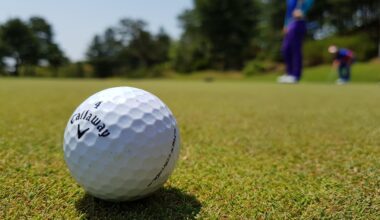How to Incorporate Olympic Lifts into Strength Competition Training
Incorporating Olympic lifts into your strength training routine enhances power, speed, and overall athletic performance. Olympic lifts, such as the snatch and clean and jerk, require proper technique and form. Focus on learning these lifts with a coach or experienced lifter to avoid injuries. Begin by practicing the lifts with a lighter bar or even just a broomstick to get comfortable with the movements. Gradually increase weight as your form improves. Incorporate different variations, such as hang cleans or front squats, to target specific muscle groups. Additionally, Olympic lifts can help improve your explosiveness, which is essential in many strength competitions. They engage multiple muscle groups, improving coordination and balance. Use these exercises as part of a well-structured routine that includes proper warm-ups, cooldowns, and mobility work. This approach not only enhances performance but also reduces injury risk. Plan your training schedule to allow for sufficient recovery time between intense sessions. Structuring your program around Olympic lifts while incorporating accessory movements can significantly boost your competition readiness. This method ultimately prepares your body for the demands of competition day.
Building Technique and Strength
To maximize the benefits of Olympic lifts, emphasize technique above all else. Dedicate specific training sessions to refining your technique. Performing lifts incorrectly can lead to injuries and subpar performance. Quality over quantity should be your mantra. Additionally, include auxiliary exercises, like power cleans or snatch pulls, that reinforce lifting mechanics. Such exercises help improve your strength and stability in both lifts. Work on flexibility as well, targeting shoulders, hips, and ankles. Increased flexibility contributes to better positions during lifts, allowing for greater weight capacity. Invest in time to increase your range of motion, as this prevents stiffness. Core strength is equally vital; exercises such as planks, squats, and deadlifts will enhance your ability to stabilize your body during lifts. Regular mobility work should be integrated into your training routine to maintain joint health. Furthermore, balance your Olympic lifting practice with other strength training methods, including powerlifting. Competitors can utilize each discipline’s techniques to optimize their outcomes, leading to significantly better performance in strength competitions. Ultimately, the synchronization of Olympic lifts and strength training fosters a well-rounded athlete.
In setting up your training schedule, it’s crucial to integrate Olympic lifts strategically. Consider dedicating a specific day solely for these movements. Target multiple repetitions at moderate weights, followed by single repetition heavy lifts. This approach combines volume training with intensity, essential for adaptation. On your dedicated Olympic lifting day, prioritize recovery and nutrition afterward. Consuming protein-rich meals post-workout fuels muscle recovery, which is necessary for progressing. Furthermore, keep in mind the importance of rest days. During these recovery days, focus on active recovery strategies such as light cardio or yoga, aiding muscle relaxation. In line with nutrition, consult with a sports dietician to structure your diet according to your training goals. Fueling your body adequately can lead to improved strength, stamina, and recovery times. Similarly, hydration is often overlooked but plays a critical role in performance. Aim for proper hydration before, during, and after training sessions. A well-hydrated athlete performs better, reducing fatigue and cramping during workouts. Accurately tracking your hydration levels alongside food intake is a great strategy for optimizing training progress and results in strength competitions.
Implementing Specific Training Regimens
When it comes to Olympic lifting for strength competitions, specificity is key. Tailor your training program based on the competition lifts. Practice snatching and clean and jerking regularly while also performing other strongman lifts like the deadlift or bench press to build overall strength. This method helps reinforce different muscle pathways, ensuring variety in your training. You should also pay close attention to the timing and pacing of your lifts. Factor in acceleration and explosiveness during your training when lifting heavier weights. Incorporating a variety of tempos in your regimen can further facilitate improvements in both strength and technique of Olympic lifts. Setting up a solid warm-up routine is crucial too. Ensure you activate your muscles effectively before lifting; consider foam rolling or dynamic stretches before your training sessions. Each workout demands an individualized approach to prepare your body adequately. Over time, track your progress and adjust your regimen accordingly. The adaptability and individualization of your training can lead to significant improvements in your overall lifting performance on competition day. This method emphasizes continual progression, adapting to challenges along the way.
In nurturing a well-rounded strength training practice, it is beneficial also to engage in mental preparation. Visualization techniques can greatly enhance performance during competition. Picture yourself executing your lifts perfectly before competition day. This mental rehearsal sets a robust framework for confidence and readiness. Additionally, engage in positive self-talk throughout your training. Repeating affirming statements can provide motivation and improve mindset. Managing anxiety is essential when approaching competitive events. Consider mindfulness and relaxation techniques, such as meditation or deep breathing workouts, to stay calm. Maintaining focus is crucial during competitions, adapting to unexpected challenges calmly. Plan your competition day, accounting for rest periods between lifts and attempts. Each lift must be executed with precision, so listen to your body and adjust. Incorporating psyching-up techniques can help channel adrenaline into productive energy. Surround yourself with a supportive team or training partner to boost morale during both training and competition. These external supports can inspire help and shared goals, amplifying motivation toward success. Cultivating this mental fortitude complements your physical preparations and builds resilience essential for facing competition strains effectively.
Leveraging Experience and Community
Engaging with the strength training community offers numerous advantages. Experiencing various lifting styles among diverse athletes encourages growth and problem-solving. Attend workshops or seminars focusing on Olympic lift techniques. These events provide insights from accomplished lifters who are eager to share their techniques and experiences. Engaging actively within local clubs or online forums can help athletes learn from one another. Connecting with knowledgeable individuals can offer guidance regarding periodization or accessory work that can be beneficial for Olympic lifting progress. Active participation in competition can also bring inspiration; watching others perform motivates you to improve your lifts. Connect with fellow competitors to build a lasting support network. Regularly sharing your training journey can lead to valuable insights and encouragement. Build relationships through social media or local meetups; these networks often develop genuine camaraderie. Having someone who shares similar goals works wonders in fostering a consistent training atmosphere. In turn, this fellowship inspires dedication and enhancement among all individuals involved in strength competitions. The continual growth and support system pave the way for success both personally and competitively.
As you advance in your Olympic lifts, emphasizing recovery techniques ensures sustainable progress over time. Post-workout recovery strategies are just as important as the lifting process itself. Adapt your recovery routine to encompass proper nutrition, hydration, sleep, and mobility work. Consuming adequate protein and carbohydrates post-training aids muscular repair and replenishes energy stores to combat fatigue. Consider using tools like foam rollers or resistance bands to enhance mobility recovery. Regularly incorporating light activity, such as swimming or walking, can reduce inflammation and improve circulation. Additionally, prioritizing quality sleep is essential for optimal recovery, aiming for at least 7-9 hours nightly. By implementing these recovery techniques, you strengthen your training gains leading to effective performance outcomes. Listen to your body and adjust your efforts if fatigue or soreness persists; these signs indicate a need for enhanced recovery. Ultimately, balancing intensity with adequate recovery will allow your body to adapt effectively, supporting long-term strength training ambitions. Fostering these elements will ensure you are ready to tackle both training and competition, enabling you to realize your personal best on competition day.
Conclusion
In conclusion, incorporating Olympic lifts into your strength training offers diverse benefits for competition readiness. By focusing on technique, utilizing progressive overload, and fostering mental preparedness, athletes can achieve outstanding performance results. Tailoring your training and recovery promotes long-term gains, ensuring you continuously progress while mitigating injury risks. Moreover, connecting with your lifting community fosters a supportive environment where sharing insights enhances motivation and growth. As you integrate these practices within your training framework, remember to commit to a process that respects your individual goals. Embrace the complexity and discipline involved in mastering Olympic lifts and understand their integral role in strength competitions. This thoughtful commitment invites personal achievement and growth while preparing you for challenges. Focusing not only on physical prowess but also on mental strength leads to holistic improvement as an athlete. Thus, preparing mentally enhances all performance aspects, instilling greater confidence. Your continued dedication combined with strategic training offers an exciting journey while preparing for competitions. Eagerly embrace the process ahead while aspiring toward excellent results. With each step forward, trust in your preparation and execution to effectively showcase your strengths on competition day.


